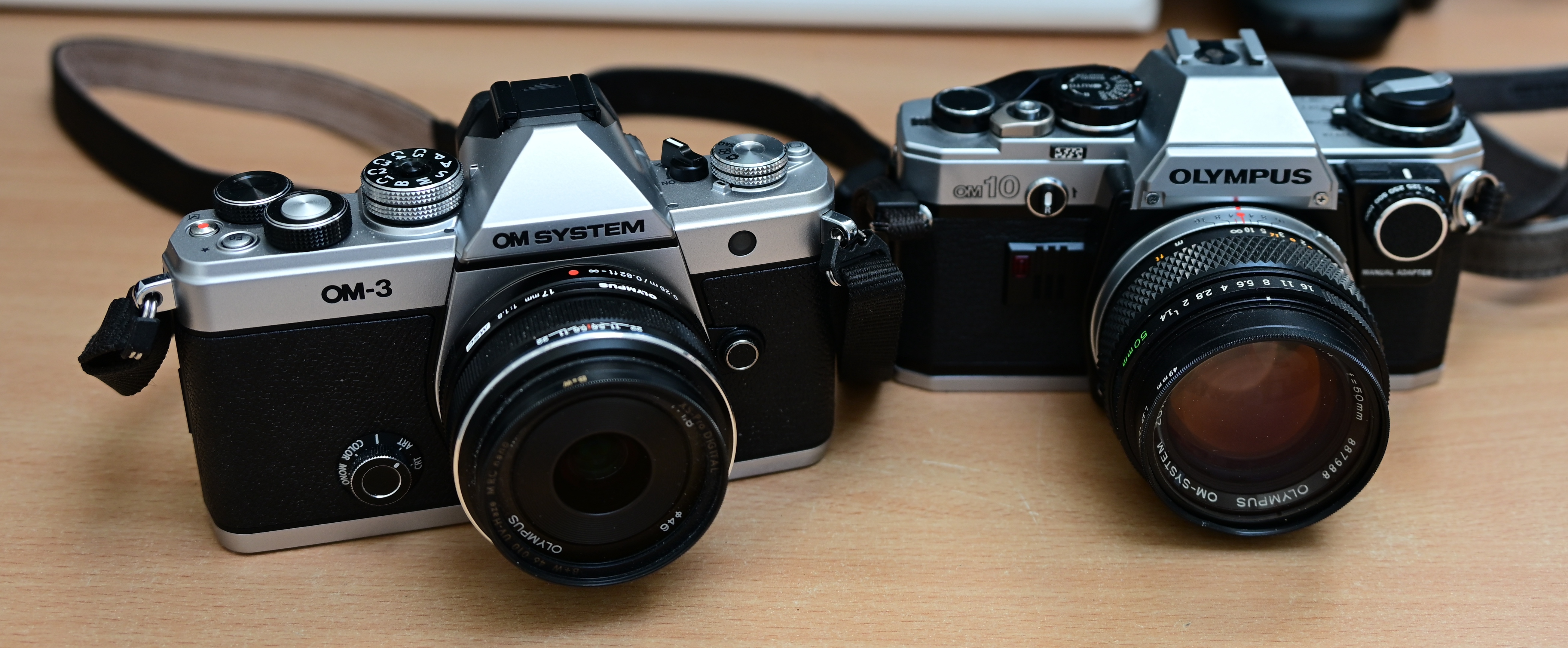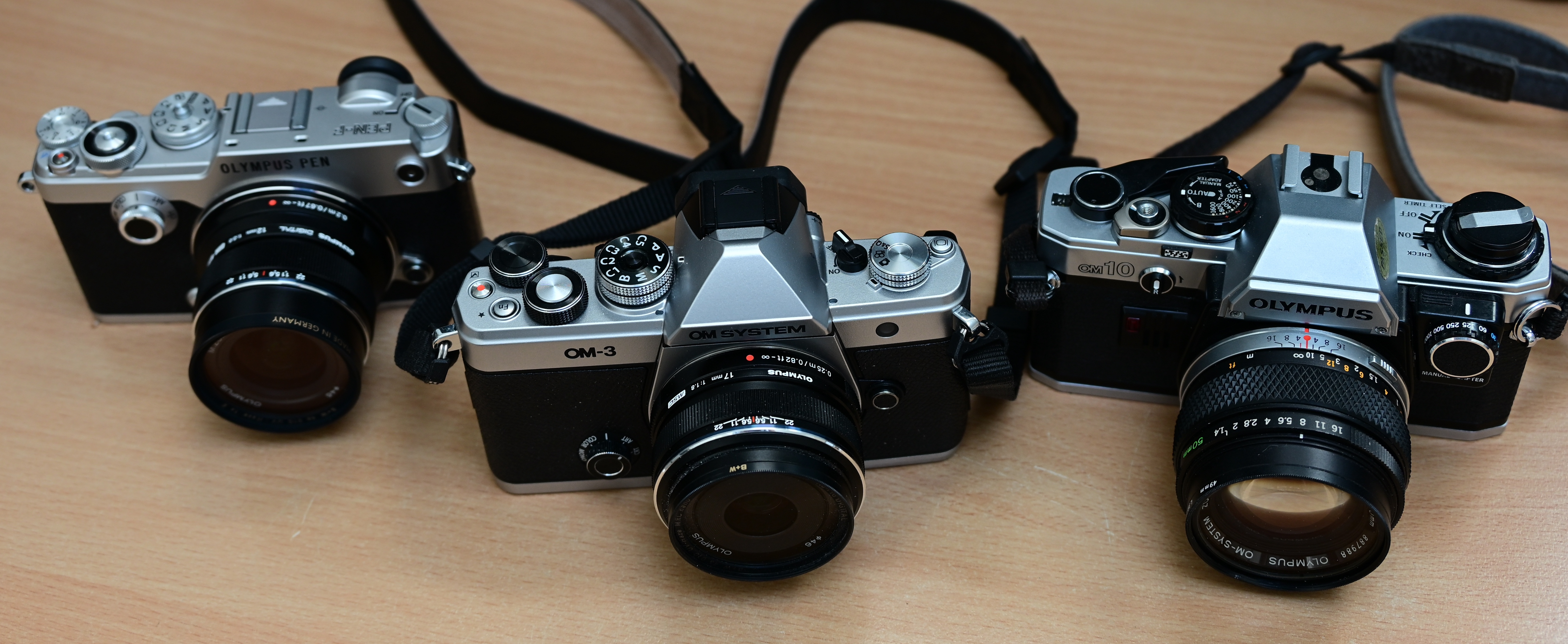OM System OM-3: a worthy and welcome successor to the Olympus Pen F
The Pen F was a hard act to follow
The Olympus Pen F was a big deal when it launched back in 2016. It showed design cues taken from the old half-frame film camera of the same name. I have owned both the film and digital Pen F cameras and liked them both very much. I still have the digital model now, and I still use it. The Pen F is a stylish, attractive and usable camera that feels right in my hand and invites me to make photographs. Being on the small side, it feels most comfortable when combined with small light primes. Luckily, the Olympus system isn't short of those; my kit bag contains 12mm f2, 17mm f1.8, 45mm f1.8 and 60mm f2.8 (macro/portrait) lenses. These, in a Hadley Pro bag, leave plenty of room for all the other knick-knacks that I like to carry with me. As you'll see below, I essentially wanted to put an updated camera into the same space.
A feature of the Pen F that I was initially a bit sniffy about is the creative dial on the front face. It felt like a gimmick, there just to give a visual hint back to its half-frame ancestor (where the shutter speed selector occupied a similar place). But actually, once I understood it, I found it to be a very useful tool. In a similar way to the film simulations on my Fujifilm cameras, you can use the creative dial essentially to create quickly-accessible recipes for different colour and monochrome effects and filters. It's also the quickest route to the Art effects. I'm not a huge user of these, but they have their uses; if you want, say, to make a monochrome image that highlights red objects in colour, or want to achieve a watercolour, or bleached bypass, or keyline effect, it's easy to do.
Like many Olympus (I suppose I must now get used to calling it OM System) users, I have hoped to see an update to the camera in order to bring in some of the newer developments in photographic technology. Not that the Pen F lacked technological features, mind you. It made excellent images and had good customisability for working the way you want to work. But Olympus has been busy in recent years, with new models bringing in improvements in batteries, autofocus, stacked sensors, computational photography and many other features. I wanted a new Pen F that took on some of these innovations while still staying true to its heritage.
I'm pleased to be able to say that the new OM System OM-3 goes a very long way to achieving that wish. This is my early impression of the new, and how it compares with the old.
Echoes of the OM film camera era
The first thing I thought of when unpacking the OM-3 was that it looks a lot like the OM film cameras of old. Several recent articles have mentioned a similarity to the OM-1; I only have an OM-10 now, but still the heritage is obvious.

Now here is the new camera, next to the Pen F.

And all three together.

The OM-3 is similar in size to the older cameras; about the same height and depth, though wider than either. It feels a little like an amalgam of both.
Like the other two cameras, there is no grip at the front - it's a completely flat face. There is a slight bulge at the back that acts as a thumb rest.
So is the lack of a grip a problem?
I've gone back and forth on this subject in my head over the years. For a long time, practically the first thing I've done after buying a camera was to buy an Arca Swiss fitting grip. This was because I used a tripod most of the time, but also to improve the grip and to protect the base plate from scuffs and scratches. I've finally landed at a point where I put a grip on cameras when I'm going to use a long lens, or a tripod, and otherwise keep it simple. And in fact I have more or less stopped carrying a tripod now; I don't like the extra weight, but more to the point image stabilisation has dramatically improved the low light capabilities of modern cameras, so tripods are less critical. I still have grips on my Nikon Zf and my Fujifilm X-T5, mainly because they both tend to be heavier with big lenses.
However, most of my cameras (OM-3, X100VI, Leica Q3 and Pen F) are now flat faced and gripless, and I'm not noticing any real problems. I'm blessed with small light lenses, which helps.
The creative dial is identical in its functions to the one on the Pen F. If you've used that, you'll be instantly at home.
If I'm comparing the OM-3 with the Pen F, I should address the question of rangefinder versus DSLR form factors. I am a big fan of the rangefinder layout - for a left eye photographer like me it feels more natural - and personally I'd have liked to have seen this approach in the new camera. However, I'm OK with DSLR design so it's not a deal-breaker for the OM-3.
I've not included any example photos, or indeed any technical comparisons between cameras or lenses. That's partly because there are plenty of resources on the internet to give you this information, partly because I don't know enought to be able to pronounce on this kind of thing, but mostly because cameras and lenses are so uniformly good nowadays. I use Micro Four-Thirds, APSC and full-frame cameras, and they all give great results. We have the luxury nowadays of access to photographic excellence in all formats, and so things such as user experience, lens choice, personal preferences and style carry more weight in our decision making. That's a good thing in my view.
Likes? There's a lot to like
I remember picking up the earlier Pen F in the Photography Show in Birmingham back at its launch. There was something about its compact design, the silver and black contrasts in the body, the classic shape, all of which made me want to pick it up and use it (Trust me, I don't always feel that way. I can respect a camera without loving it; I'm looking at you, Nikon D750). Well, that's how I felt when I picked up the OM-3. It's a camera that invites you to take photographs.
Apart from that gut feel, there is a lot to like about the OM-3 in terms of practical features. The body seems to be largely metal, and it is weather-resistant (IP53). It has in-body image stabilisation, which is a real boon for me with my trembly hands. It features a stacked sensor, the technical merits of which slightly escape me, though I understand that it's a Good Thing. It uses the much nicer new user interface in the menu system (one of the areas of improvement over the Pen F - Olympus menu systems used to be a by-word for complexity and inconsistency). It uses the higher capacity BLX-1 battery which is a huge improvement over the old BLN-1 in the Pen F.
In fact, from the reviews that I've read it seems to be essentially an OM-1 Mk II in a different body and at a lower price.
Niggles? I have a few
The OM-3 has the power switch on the left, in keeping with Olympus tradition. I prefer the placement of the power switch around the shutter button used by all of my other cameras (like Fujifilm, Nikon and Leica). If I were that bothered about this point I'd never use an Olympus, of course. I'm more bothered by the fact that the switch itself is small and a little bit fiddly. While we're in this area, there is a larger knurled wheel allowing you to select stills or video modes, but strangely also "S&Q". I think this is related to slow motion video. Still, I have zero interest in video so it's wasted space for me; I just leave it on the still setting. The mushy function lever (see below) is just more wasted space for me.
Only one card slot, but it's UHS-II which is something. Actually, now I come to think of it, my X-T5 is the only camera that I own that has two full-sized SD card slots. I don't count the rather weird setup on the Zf, which takes one UHS-II full sized card and one UHS-I micro-SD card; I tend to think of that cardlet as a kind of insurance policy and really forget that it's there most of the time.
The function lever around the CP button on the back of the camera has a mushy, imprecise action. It's quite different from the way the similar switch works on the OM-1 which has quite a distinct positive action. I can't see me using it much, so I've left it on the "1" setting.
Next is not so much a niggle as a source of slight bafflement. The camera has a set of custom mode settings - C1-C5. Given the creative dial and the ease of access to the Super Control Panel settings, I'm struggling to think of what I would want to save as a custom setting. Limited imagination, I suppose, and illumination may come to me in time.
To a more personal preference point; my thumb seems to land naturally on the CP button for the AF-ON function, so that's where I've moved it (the menu system is quite good for customisation). I've used the button labelled AF-ON to provide the magnify function (which is about where it is located on the Pen F, so again, I'm right at home).
One last gripe; I have configured the arrow pad around the OK button set to provide button functions, like setting the focus point, ISO and self-timer. But for some reason the "up" arrow on this pad cannot be configured to do anything. Can't think why not.
And that's about it for niggles. In all other respects, from my initial experience, this is an excellent camera for a wide range of applications, and it is indeed a worthy successor to the Pen F.